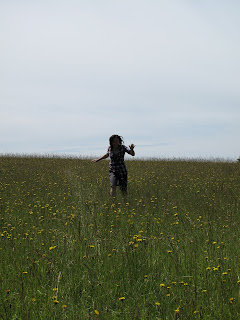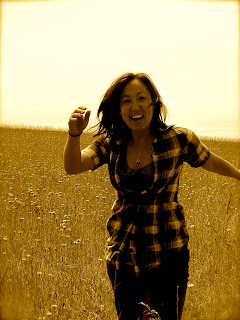Nine months since my last entry. I just did the math and smiled when I realized the significance. This period of my life has felt uncannily gestational, a re-birth in the making.
Nine months ago, I was leaving Alaska, a tiny cargo trailer full of my grandparents' heirloom furniture hitched to the back of my Jeep Liberty, my cat in the front seat, the two of us bound for a modest, green parcel of farmland in the Willamette Valley of Oregon.
 The long ride, first on the Matanuska ferry, then across the Prince Rupert Highway, through Canada at the height of the fall, past miles of brightly painted hillsides and through tapering amber sunsets, gave me the time and space I needed to steep in all the bittersweet feelings I had about moving away.
The long ride, first on the Matanuska ferry, then across the Prince Rupert Highway, through Canada at the height of the fall, past miles of brightly painted hillsides and through tapering amber sunsets, gave me the time and space I needed to steep in all the bittersweet feelings I had about moving away.Here are a few photos I snapped on the journey...
Arriving at my family's farmhouse in Oregon, I unpacked my few bags and set a mattress out on the floor. I felt like a wayward divorcee, nervous, emotionally spent, fragile as a weathered bone.
But as fall turned to winter, and winter to spring, as I bucked hay to feed the sheep, nurtured seedlings in the greenhouse, and carried yet another damp, wriggling, newborn lamb into a stall to bond with its mother, I felt myself beginning to thaw, the hard spots in me giving way like calving glaciers.
 Fast forward nine months, and I have just past the hundred-page milestone of a book I never thought I'd write, I'm up to my eyeballs in juicy red strawberries, and I finally realized that I like it here enough to hang some curtains in my bedroom and raise my mattress off the floor.
Fast forward nine months, and I have just past the hundred-page milestone of a book I never thought I'd write, I'm up to my eyeballs in juicy red strawberries, and I finally realized that I like it here enough to hang some curtains in my bedroom and raise my mattress off the floor.Though still very much a work in progress, I also feel ready to share this process of living on the farm and writing a book, originally inspired by the experiences that launched 1000 Cranes, a social movement of suicide prevention, and my two year journey from a remote native village on the Bering Strait of Alaska to a 40 acre farmstead in rural Oregon. With editing feedback from my mentor, novelist Jo-Ann Mapson, I have begun to re-trace my life's touchstones, collecting them, like paper cranes, into a developing memoir, excerpts of which I plan to share with you here, along with updates from my new life out on the farm.
While the things you read on this blog may eventually find their way to the editing room floor, especially as this book continues to undergo the surprisingly organic process of growing and sloughing, I hope you find something of value in the parade of words, however ephemeral.
 Please feel free to join me by adding your comments, suggestions, and perhaps even some of your own memories to the conversation. A walk down memory lane is wonderful, but never quite as nice as sharing a walk with a friend.
Please feel free to join me by adding your comments, suggestions, and perhaps even some of your own memories to the conversation. A walk down memory lane is wonderful, but never quite as nice as sharing a walk with a friend.Without further ado, here's the first (ack!) tiny excerpt from the memoir-in-progress:
August 2012, Inside Passage
The deadbolt taps inside its lightweight frame like a sparrow. The furniture in the room, pressboard desk, stackable chair, and shortened twin bunks sit idle, showing none of the stress of the fluttering lock. Only the swinging hangars, with their occasional gossip-like clatter, expose the massive ferry’s heaving pitch and rumbling engine.
I lie awake on a thick foam mattress and listen. I wonder if each of the Matanuska’s modest staterooms comes with a similar indecisive latch. I debate turning the lock to free the deadbolt, ultimately deciding against it, unwilling to risk falling asleep beside an open door. Despite the chatter, I find myself soothed by the deep purr of the ferry’s engine, drifting in and out of sleep, comforted by the low hum, the scratchy fleece bedspread against my skin, and the giant ship’s womb-like sway.
Three days from now, when this boat docks in Prince Rupert, British Columbia, I will officially have left Alaska to start my life over. Outside. I’m as nervous about this as a divorcée, full of fear, promise, and the deepening realization that I am already moving forward, that I am in-between, that I've called my own bluff. In truth, all I really know is that I have to keep going towards a finish line: forty acres in the heart of the Willamette Valley, towards a homecoming, or respite, or, if I’m being painfully honest, towards what I hope is an escape from this cloud of death that's been surrounding me like a thickening mist, closing in with increasing ferocity.
For me, life in Alaska had fast become a shrinking room. Like the indecisive lock, I’d begun hitting wall after wall with regard to patience, growth, my own sanity, all now hanging dented and compromised from the rough and reckless treatment. August had arrived in Anchorage, and with it, the crisp bite of fall, maybe only a few more weeks before another winter's darkness came seeping in, lying low around the edges like poison gas. Ten years I’d spent there, building a life and a career, filling my home with antique furniture, artwork, the warm aromas of slow-cooked stews and butterscotch oatmeal cookies. Ten years spent learning the names and lives of my local café and gas station employees. Ten years memorizing the natural landmarks on my favorite weekend drives, the dinner menus of Bear Tooth Theatre Pub, Spenard Roadhouse, the crisp smell of fresh fallen snow, the see-saw tipping of the equinoxes, the spectacles infinite light beams cast through suspended ice crystals, and the churning, grit-grey moonscapes of the frozen mudflats. Ten summers I’d counted down on the laddered blooms of the fireweed, watching their consecutive blossoms creep along like dynamite fuses before lighting up the hillsides with glorious dying bursts of orange, fuschia and fire engine red. Ten soul searching years I'd weathered until Alaska’s ferocious melancholy finally threatened to swallow me whole and I’d surrendered, turned in my one year’s notice at the university, purged all of my worldly possessions, and fled.






























